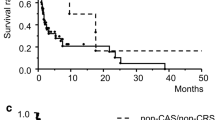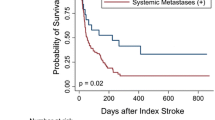Abstract
Stroke is the second most frequent neurologic finding in postmortem studies of cancer patients. It has also been described as the first expression of an occult cancer. We have studied patients diagnosed with cancer after an ischemic stroke (IS) and we analyze differences with non-tumor patients. Single cohort longitudinal retrospective study of patients admitted to our center with IS diagnosis from 1 January 2012 to 12 December 2014. All patients were followed for 18 months. Patients with transient ischemic infarction or cerebral hemorrhage, active cancer or in the last 5 years, inability to follow-up or absence of complete complementary study (holter-EKG, echocardiogram, and dupplex/angiography-CT) were excluded. Demographic, clinical, analytical and prognostic characteristics were compared between both subgroups. From a total of 381 IS patients with no history of cancer, 29 (7.61%) were diagnosed with cancer. The mean time from stroke onset to cancer diagnosis was 6 months. The most frequent location was colon (24%). 35% were diagnosed in a metastatic stage. Older age (p = 0.003), previous cancer (p = 0.042), chronic kidney disease (CKD) (p = 0.006) and lower hemoglobin (p = 0.004) and fibrinogen (p = 0.019) values were predictors of occult neoplasm. No differences were found in other biochemical or epidemiological parameters, prognosis, etiology or clinical manifestations of the IS. In our study, older age, CKD, previous cancer and hemoglobin and fibrinogen values were related to the diagnosis of cancer after IS. More studies are needed to determine which patients could benefit from a larger study on admission that might allow an earlier diagnosis of the underlying neoplasm.


Similar content being viewed by others
References
Graus F, Rogers LR, Posner JB (1985) Cerebrovascular complications in patients with cancer. Medicine (Baltimore) 64(1):16–35
Selvik HA, Thomassen L, Logallo N, Næss H (2014) Prior cancer in patients with ischemic stroke: the Bergen NORSTROKE study. J Stroke Cerebrovasc Dis 23(5):919–925. https://doi.org/10.1016/j.jstrokecerebrovasdis.2013.07.041
Romeiro AC, Valadas A, Marques J (2015) Acute ischemic stroke on cancer patients, a distinct etiology? a case-control study. Acta Med Port 28(5):613–618
Dearborn JL, Urrutia VC, Zeiler SR (2015) Stroke and cancer—a complicated relationship. J Neurol Transl Neurosci 2(1):1039
Stefan O, Vera N, Otto B, Heinz L, Wolfgang G (2009) Stroke in cancer patients: a risk factor analysis. J Neurooncol 94(2):221–226. https://doi.org/10.1007/s11060-009-9818-3
Bang OY, Seok M, Kim G, Hong M, Kim Y, Lee J (2011) Ischemic stroke and cancer: stroke severely impacts cancer patients, while cancer increases the number of strokes subtypes of stroke and cancer. J Clin Neurol 7:53–59
Kim SJ, Park JH, Lee M, Park YG, Ahn M, Bang OY (2012) Clues to occult cancer in patients with ischemic stroke. PLoS ONE 7(9):e44959. https://doi.org/10.1371/journal.pone.0044959
Giray S, Sarica FB, Arlier Z, Bal N (2011) Recurrent ischemic stroke as an initial manifestation of an concealed pancreatic adenocarcinoma: Trousseau’s syndrome. Chin Med J (Engl) 124(4):637–640. https://doi.org/10.3760/cma.j.issn.0366-6999.2011.04.030
Arabi M, Saleh Z, Sawaya R (2009) Cryptogenic stroke as a very eraly manifestation of pancreatic neoplasm. EXCLI J 8:118–120
Mirza HZ, Zuberi BJ, Zein TM, Mirghani Z (2013) Ischaemic stroke as the first presentation of occult squamous cell cancer. J Coll Phys Surg Pak 23(6):437–439.
Woo PY, Chan DT, Cheung TC, Zhu X, Poon W (2014) Middle cerebral artery infarction in a cancer patient: a fatal case of Trousseau’s syndrome. Hong Kong Med J 20(1):74–77. https://doi.org/10.12809/hkmj133780
Navi BB, DeAngelis LM, Segal AZ (2007) Multifocal strokes as the presentation of occult lung cancer. J Neurooncol 85(3):307–309. https://doi.org/10.1007/s11060-007-9419-y
Paris EM (2015) Multiple cerebral infarctions in the context of malignancy. Malta Med J 27(1):47–48
Ines PC, Esposo EA, Bocobo JC (2012) Multiple ischemic strokes as the initial presentation of a concealed pancreatic malignancy: Trousseau’s syndrome. Philipp J Intern Med 50(1):34–39
Tsai C-C, Wu M (2015) Frequent ischemic stroke as first manifestation of occult colon cancer: a rare case. Am J Case Rep 16:723–727. https://doi.org/10.12659/AJCR.895130
Pérez-lázaro C, Santos S, Morales-rull JL, Garcés-redondo M, Corral-beamonte E (2004) Ictus como primera manifestación de una neoplasia pancreática oculta. Rev Neurol 38(4):332–335
Borowski A, Ghodsizad A, Gams E (2005) Stroke as a first manifestation of ovarian cancer. J Neurooncol 71(3):267–269. https://doi.org/10.1007/s11060-004-1394-y
Johnson CJ, Kittner SJ, McCarter RJ, Sloan MA, Stern BJ, Buchholz D et al (1995) Interrater reliability of an etiologic classification of ischemic stroke. Stroke 26(1):46–51
Adams HP, Bendixen BH, Kappelle LJ, Biller J, Love BB, Gordon DL et al (1993) Classification of subtype of acute ischemic stroke. Definitions for use in a multicenter clinical trial. TOAST. Trial of Org 10172 in acute stroke treatment. Stroke 24(1):35–41
Cocho D, Gendre J, Boltes A, Espinosa J, Ricciardi AC, Pons J et al (2015) Predictors of occult cancer in acute ischemic stroke patients. J Stroke Cerebrovasc Dis 24(6):1324–1328. https://doi.org/10.1016/j.jstrokecerebrovasdis.2015.02.006
Taccone FS, Jeangette SM, Blecic SA (2008) First-ever stroke as initial presentation of systemic cancer. J Stroke Cerebrovasc Dis 17(4):169–174. https://doi.org/10.1016/j.jstrokecerebrovasdis.2008.01.007
Uemura J, Kimura K, Sibazaki K, Inoue T, Iguchi Y, Yamashita S (2010) Acute stroke patients have occult malignancy more often than expected. Eur Neurol 64(3):140–144. https://doi.org/10.1159/000316764
Selvik HA, Thomassen L, Bjerkreim AT, Næss H (2015) Cancer-associated stroke: the Bergen NORSTROKE study. Cerebrovasc Dis Extra 5(3):107–113. https://doi.org/10.1159/000440730
Schwarzbach CJ, Schaefer A, Ebert A, Held V, Bolognese M, Kablau M et al (2012) Stroke and cancer: the importance of cancer-associated hypercoagulation as a possible stroke etiology. Stroke 43(11):3029–3034. https://doi.org/10.1161/STROKEAHA.112.658625
NCCN Clinical Practice Guidelines in Oncology (2017) B-cell lymphomas. Version I. December 7, 2016
NCCN Clinical Practice Guidelines in Oncology (2017) Colon cancer. Version I. November 23, 2016
NCCN Clinical Practice Guidelines in Oncology (2017) Non small lung cancer. Version 3. November 16, 2016
NCCN Clinical Practice Guidelines in Oncology (2017) Prostate cancer. Version I. December 16, 2016
Kwon HM, Kang BS, Yoon BW (2007) Stroke as the first manifestation of concealed cancer. J Neurol Sci 258(1–2):80–83. https://doi.org/10.1016/j.jns.2007.02.035
Ito S, Ueda A, Murate K, Hirota S, Fukui T, Ishikawa T et al (2007) Differentiation of cancer from atrial fibrillation in patients with acute multifocal stroke. J Neurol Sci 368:344–348. https://doi.org/10.1016/j.jns.2016.07.054
Kim SG, Hong JM, Kim HY, Lee J, Chung P, Park K et al (2010) Ischemic stroke in cancer patients with and without conventional mechanisms: a multicenter study in Korea. Stroke 41(4):798–801. https://doi.org/10.1161/STROKEAHA.109.571356
Guo YJ, Chang MH, Chen PL, Lee YS, Chang YC, Liao YC (2014) Predictive value of plasma d-dimer levels for cancer-related stroke: a 3-year retrospective study. J Stroke Cerebrovasc Dis 23(4):e249–e540. https://doi.org/10.1016/j.jstrokecerebrovasdis.2013.10.022
Varki A (2007) Trousseau’s syndrome: multiple definitions and multiple mechanisms. Blood 110(6):1723–1729. https://doi.org/10.1182/blood-2006-10-053736
Khorana AA, Francis CW, Culakova E, Kuderer NM, Lyman GH (2007) Frequency, risk factors, and trends for venous thromboembolism among hospitalized cancer patients. Cancer 110(10):2339–2346. https://doi.org/10.1002/cncr.23062
Falanga A, Russo L, Verzeroli C (2013) Mechanisms of thrombosis in cancer. Thromb Res 131(SUPPL.1):S59-S62. https://doi.org/10.1016/S0049-3848(13)70024-0
Masrur S, Abdullah AR, Smith EE, Hidalgo R, El-Ghandour A, Rordorf G et al (2011) Risk of thrombolytic therapy for acute ischemic stroke in patients with current malignancy. J Stroke Cerebrovasc Dis 20(2):124–130. https://doi.org/10.1016/j.jstrokecerebrovasdis.2009.10.010
Murthy SB, Karanth S, Shah S, Shastri A, Rao CPV, Bershad EM et al (2013) Thrombolysis for acute ischemic stroke in patients with cancer: a population study. Stroke 44(12):3573–3576. https://doi.org/10.1161/STROKEAHA.113.003058
Funding
This research received no specific grant from any funding agency in the public, commercial or not-for-profit sectors.
Author information
Authors and Affiliations
Corresponding author
Ethics declarations
Conflict of interest
The authors declare that they have no conflict of interest.
Rights and permissions
About this article
Cite this article
Quintas, S., Rogado, J., Gullón, P. et al. Predictors of unknown cancer in patients with ischemic stroke. J Neurooncol 137, 551–557 (2018). https://doi.org/10.1007/s11060-017-2741-0
Received:
Accepted:
Published:
Issue Date:
DOI: https://doi.org/10.1007/s11060-017-2741-0




